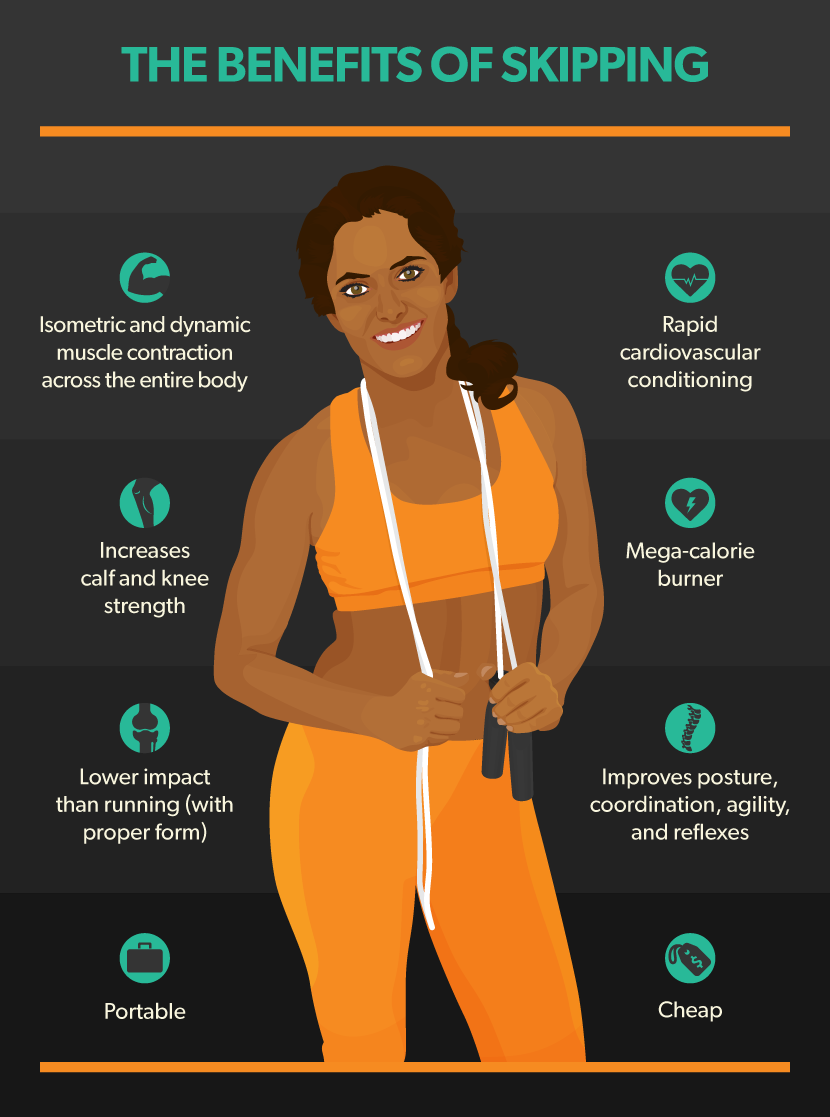Hop to it! A Guide to Exercising With a Jump Rope
As a kid, skipping with jump rope was a rite of passage; it was how you knew you were becoming one of the big kids. As an
adult, using a jump rope is much less common. However, what is a better low-budget, high-intensity exercise that you can do
from home? Whether it’s to stretch, to get those knees up, or to get your heartbeat racing – don’t underestimate the power of
jump rope exercises.
Jumping rope is more than just singing songs in time to the beat of the rope’s swings. In fact, when done at moderate to
hard intensity, jumping rope burns as many calories as running and spinning – two of the greatest calorie scorchers out there!
When done properly and without heavy landing, jumping rope can even be gentler on your joints than running, as well as over a
shorter amount of time. Jumping rope also works muscles that complement running muscles, so it can be a great cross training
exercise for runners and injured runners.

Virtually anyone can jump rope, but if you have any pre-existing or current knee injuries, consult a physical therapist for
strengthening exercises and advice prior to picking up the rope. Ankles are also a concern as even though jumping rope
strengthens and helps to stabilize the ankles, some prep work might be necessary to get the most from your workout and to
avoid injury.
As with starting any workout program, start small and work your way up to high intensities and longer durations. Jumping
rope also requires a degree of coordination, so remember that you will get fitter once you have mastered the action of jumping
rope, but you must also get fitter to master the action. In short, expect a learning curve the first handful of sessions!
To get started jumping rope, first select the best rope for your needs. The beaded ropes are great for beginners because
they hold shape a bit more and do not sting quite so much when they hit you! However, as you get better, you are going to find
that you might need a speed rope for more complicated moves such as double unders, which is when you have two revolutions of
the jump rope per jump you take.
More important than the type of rope is the fit. To test fit, hold the rope under one foot and lift the handles towards your
shoulders. The handles should just reach your armpits. Also, practice good form with your hands at 10 and 2 o’clock and at
waist height. Revolve the rope from the wrists, not the shoulders, and try to keep your arms relatively still, unless you are
doing a move that requires them to extend, such as a figure-eight cross.
As with any activity, injury can occur. Most common are superficial injuries like skin welts from slapping yourself in the
legs. But also realize that you are working your ankles, calves, and knees rather hard, and if you are not used to that level
of activity, you may need to invest in recovery aids such as compression socks, a foam roller, or simply rest days. Switch up
your workout as well, adding variety to your routines and switching between long duration, low to moderate intensity, and short
duration, high intensity, workouts.
Always start with a warm up. Instead of jumping rope, which will be your workout, jog in place for 30 seconds, do 30 high
knees, 30 air squats, and repeat for 3-5 minutes. At the end, engage in gentle stretching of hamstrings, calves, and
quadriceps as well as your back and chest.

Beginners should pick jump rope workouts that are uncomplicated and with shorter intervals so that you can work on
form, develop fitness, and grow your workout by multiplying the number of rounds. A great jump rope workout for beginners
might include 30-60 successful jumps, 30 air squats, 30 high knees, and 30 standing straight-leg toe taps, repeated 4-5
times. Work to increase each of those numbers and minimize rest breaks.
As your cardiovascular fitness and coordination improve, start to add in more complicated intervals. Aim for as many as
500 jumps as an interval, and try to take out any intermittent bounces between jumps over the rope. Add in speed and
directional changes, jump on one foot, and criss-cross the rope in front of you (in a figure 8). The “ultimate” jump rope
move in many fitness arenas is the double under, which requires you to jump higher and swing faster than the typical jump.
Stringing multiple double unders in a row is the true mark of a fit rope jumper.
Jumping rope is exhausting, hard work; do not be surprised if you can only handle a minute or two at a time when you
start out! If jumping rope is to be the focus of your workout, set a goal of continuously jumping for 20-30 minutes, but
don’t be surprised if this takes some time! Use changes in speed and direction as well as jumping side to side or on one
leg to stave off boredom, put on motivating songs, or even watch TV, using the commercials as work intervals.

If using jump rope as a cardio interval, insert it into your circuit workout for 2-3 minutes at moderate intensity, or
30 seconds to 1 minute of all-out work. Incorporating bodyweight moves such as pushups or triceps dips, core and abdominal
work such as planks, and other forms of cardio such as sprint intervals, are also great ways to keep your body guessing
without needing any extra equipment.
You may associate jump ropes with pigtails, ribbons, and rhymes, but jumping rope for fitness is anything but child’s
play. Try out one of these workouts and watch your cardiovascular fitness grow, the pounds drop, and the sweat pour!
Embed the article on your site

